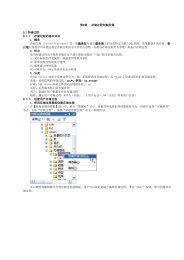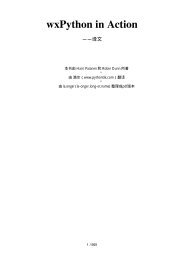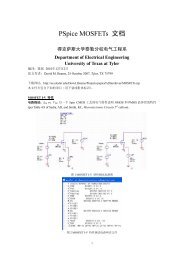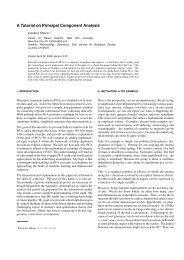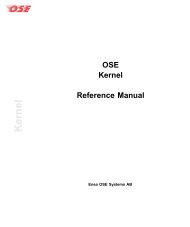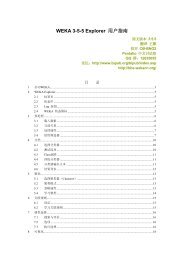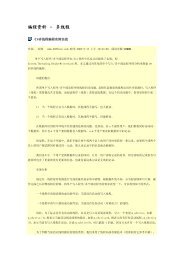Exception Handling ABI for the ARM Architecture
Exception Handling ABI for the ARM Architecture
Exception Handling ABI for the ARM Architecture
Create successful ePaper yourself
Turn your PDF publications into a flip-book with our unique Google optimized e-Paper software.
<strong>Exception</strong> handling <strong>ABI</strong> <strong>for</strong> <strong>the</strong> <strong>ARM</strong> architecture<br />
or<br />
N|0x80000000 type_info 1 ... type_info N landing_pad_offset<br />
where N is an unsigned integer count (up to 31 bits) and type_info i is a reference to a type_info object <strong>for</strong><br />
a type which may be passed and which results from an R_<strong>ARM</strong>_TARGET2 relocation. The N==0 case<br />
represents <strong>the</strong> situation in which no types may be passed, corresponding to <strong>the</strong> source syntax 'throw()'. If<br />
<strong>the</strong> high bit is set in <strong>the</strong> word containing N, <strong>the</strong>n <strong>the</strong> type_info list is followed by a prel31 landing pad offset<br />
(with bit 31 clear) to be entered in <strong>the</strong> event that no type matches <strong>the</strong> thrown type. High bit clear in <strong>the</strong> N<br />
word signifies that implicitly <strong>the</strong> no match case should result in a call to __cxa_call_unexpected. When <strong>the</strong><br />
high bit clear <strong>for</strong>mat is used, object producers must emit an R_<strong>ARM</strong>_NONE relocation to<br />
__cxa_call_unexpected to indicate <strong>the</strong> dependency to <strong>the</strong> linker.<br />
Descriptors are listed in depth first block order so that all applicable descriptors can be processed in a single linear<br />
scan of <strong>the</strong> handling table entry. Section §9.4 explains how <strong>the</strong> personality routine processes a table.<br />
Note<br />
Recall that when <strong>the</strong> personality routine returns _URC_FAILURE, <strong>the</strong> language-independent unwinder<br />
will (in phase 1) return to its caller <strong>for</strong> a language-dependent response or (in phase 2) will call abort<br />
immediately. If <strong>the</strong> caller is C++, <strong>the</strong> language-dependent response in phase 1 is to call terminate(). See<br />
§7.3 and §7.4 <strong>for</strong> more details.<br />
9.3 Frame unwinding instructions<br />
The encoding makes only general assumptions about compiler implementations. For example, we assume that:<br />
code generators will prefer to:<br />
<br />
<br />
Use a compact subset of <strong>the</strong> callee-saved registers starting with r4—{r4}, {r4, r5}, {r4-r6}, … {r4-r11}—ra<strong>the</strong>r<br />
than an arbitrary subset.<br />
Maintain 8-byte stack alignment by saving {r4-r11, ip, lr} when {r4-r11, lr} must be saved.<br />
Table 4, below, describes <strong>the</strong> <strong>ARM</strong>-defined frame-unwinding instructions used by personality routines 0, 1, and 2.<br />
Each instruction modifies a virtual stack pointer (vsp).<br />
The implicit value of vsp at <strong>the</strong> start of a sequence of unwinding instructions is <strong>the</strong> value of sp that identifies <strong>the</strong><br />
frame being unwound.<br />
Upon completion of <strong>the</strong> unwinding instructions, <strong>the</strong> return address into <strong>the</strong> previous function must be in VRS[r15].<br />
The encoding has been designed to meet <strong>the</strong> following criteria.<br />
It should be possible to unwind almost all frames using 3 or fewer unwinding instructions (short <strong>for</strong>mat).<br />
The frame unwinding instructions should (in principle) be straight<strong>for</strong>ward to generate from DWARF<br />
.debug_frame descriptions.<br />
The following remarks clarify <strong>the</strong> table:<br />
a) Code 0x80 0x00, Refuse to unwind, causes <strong>the</strong> PR to return _URC_FAILURE and hence prevents<br />
throwing out of <strong>the</strong> current function. Its behaviour is thus similar to EXIDX_CANTUNWIND (see §5) but it<br />
permits descriptors in <strong>the</strong> function body.<br />
b) ‘Pop’ generally denotes removal from <strong>the</strong> stack commencing at current vsp, with subsequent increment of<br />
vsp to beyond <strong>the</strong> removed quantities. The sole exception to this rule is popping r13, when <strong>the</strong> writeback<br />
of <strong>the</strong> loaded value to vsp is delayed until after <strong>the</strong> whole instruction has completed. When multiple<br />
registers are popped by a single instruction <strong>the</strong>y are taken as lowest numbered register at lowest stack<br />
address.<br />
c) Code 0xb0, Finish, conditionally copies VRS[r14] to VRS[r15] and also indicates that no fur<strong>the</strong>r<br />
instructions are to be processed <strong>for</strong> this frame. The copy is per<strong>for</strong>med only if <strong>the</strong> personality routine has<br />
not already updated VRS[r15] while unwinding <strong>the</strong> frame.<br />
d) When popping N VFP registers saved (as if) by FSTMX, vsp is incremented by 8N + 4 and valid registers<br />
are D0-D15. When popping N VFP registers saved (as if) by FSTMD, vsp is incremented by 8N, valid<br />
registers are D0-D31, and more than 16 registers may be specified in a single unwind instruction<br />
(machine FSTMD/FLDMD instructions have a limit of 16 registers).<br />
<strong>ARM</strong> IHI 0038A Copyright © 2002-2005, 2007 <strong>ARM</strong> Limited. All rights reserved. Page 40 of 50



